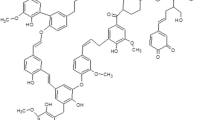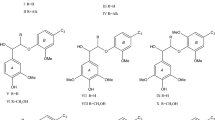Abstract
Lignins, a truly abundant group of biopolymers exhibiting some significant diversity, are usually thought to be constituted by a random proportionate distribution of ten different linkages between p-hydroxphenylpropane units. Over 20 million tons of kraft lignin derivatives are produced annually in the United States by the pulping industry, but 99.9% of these aromatic polymeric materials are consumed as fuel. Such industrial byproducts are generally viewed as being almost hopelessly complicated mixtures of partially degraded and condensed chemical species. However, a very different picture has begun to emerge from a more coherent understanding of the physicochemical behavior exhibited by kraft lignin preparations. Noncovalent interactions between the individual molecular components under a variety of solution conditions orchestrate pronounced associative processes that are characterized by a remarkable degree of specificity. Their consequences may be readily observed both size-exclusion chromatographically and electron microscopically, and are reflected in an anomalous variation of glass transition temperature, Tg, with molecular weight of paucidisperse kraft lignin fractions. How these effects may influence the mechanical properties of lignin-based polymeric materials is presently being scrutinized at the University of Minnesota.
Similar content being viewed by others
References
A. Sakakibara, Wood Sci Technol. 14, 89 (1980).
H. Grisebach, in The Biochemistry of Plants: 7. Secondary Plant Products, edited by E.E. Conn (Academic Press, New York, 1981), p. 457.
A. Scalbert, B. Monties, J.-Y. Lallemand, E. Guittet, C. Rolando, Phytochemistry 24, 1359 (1985).
Y. Musha, D.A.I. Goring, Wood Sci. Technol. 9, 45 (1975).
N. Terashima, Y. Tomimura, H. Araki, Mokuzai Gakkaishi 25, 595 (1979).
D.A.I. Goring, in Biosynthesis and Biodegradation of Wood Components, edited by T. Higuchi (Academic Press, New York, 1985), p. 161.
K. Forss, K.-E. Fremer, Pap. Puu 47, 443 (1965).
K. Forss, K.-E. Fremer, Appl. Polym. Symp. 37, 531 (1983).
W.J. Connors, S. Sarkanen, J. L McCarthy, Holzforschung 34, 80 (1980).
M. Wayman, T.I. Obiaga, Can. J. Chem. 52, 2102 (1974).
J.F. Yan, F. Pla, R. Kondo, M. Dolk, J. L McCarthy, Macromolecules 17, 2137 (1984).
S. Dutta, T.M. GarverJr., S. Sarkanen, ACS Symp. Ser. 397, 155 (1989).
S. Sarkanen, D.C. Teller, C.R. Stevens, J. L McCarthy, Macromolecules 17, 2588 (1984).
S.Y. Lin, in Progress in Biomass Conversion, Vol.4, edited by D.A. Tillman, E.C. Jahn (Academic Press, New York, 1983), p. 31.
A.G. Kirkman, J.S. Gratzl, L.L. Edwards, Tappi 69 (5), 110 (1986).
J. Gierer, Wood Sci Technol. 14, 241 (1980).
T.M. GarverJr., S. Sarkanen, in Renewable-Resource Materials: New Polymer Sources, edited by C.E. Carraher, Jr., L H. Sperling (Plenum Publishing Corporation, New York, 1986), p. 287.
J. Gierer, I. Pettersson, I. Szabo-Lin, Acta Chem. Scand. B 28, 1129 (1974).
J. Gierer, F. Imsgard, I. Norén, Acta Chem. Scand. B 31, 561 (1977).
G. Gellerstedt, E.L. Lindfors, C. Lapierre, B. Monties, Svensk Papperstidn. 87, R61 (1984).
H.-m. Chang, J.S. Gratzl, in Chemistry of Delignification with Oxygen, Ozone and Peroxides, edited by J.S. Gratzl, J. Nakano, R.P. Singh (Uni Publishers, Tokyo, 1980) p. 151.
S. Sarkanen, D.C. Teller, J. Hall, J. L McCarthy, Macromolecules 14, 426 (1981).
E. Tsuchida, K. Abe, Adv. Polym. Sci. 45, 77–85 (1982).
D.A.I. Goring, R. Vuong, C. Gancet, H. Chanzy, J. Appl. Polym. Sci. 24, 931 (1979).
M.J. Richardson, Proc. Roy. Soc. A 279, 50 (1964).
Lignin: Properties and Materials, edited by W.G. Glasser, S. Sarkanen (American Chemical Society, Washington, D.C., 1989), ACS Symp. Ser.397.
H. Yoshida, R. Mörck, K.P. Kringstad, H. Hatakeyama, Holzforschung 41, 171 (1987).
J.M.G. Cowie, Eur. Polym. J. 11, 297 (1975).
Acknowledgments
Acknowledgment for support of this research is made to the United States Department of Agriculture (Grant 86-FSTY-9-0166), the Legislative Commission on Minnesota Resources, the Blandin Foundation, the Graduate School of the University of Minnesota, the Minnesota Agricultural Experiment Station, and the University of Minnesota Computer Center. The authors are indebted to G.G. Ahlstrand, Department of Plant Pathology at the University of Minnesota, for expert technical contributions to the studies employing transmission electron microscopy.
Author information
Authors and Affiliations
Rights and permissions
About this article
Cite this article
Dutta, S., Sarkanen, S. A New Emphasis in Strategies for Developing Lignin-Based Plastics. MRS Online Proceedings Library 197, 31–39 (1990). https://doi.org/10.1557/PROC-197-31
Published:
Issue Date:
DOI: https://doi.org/10.1557/PROC-197-31




